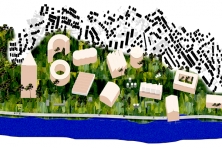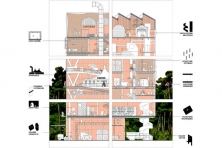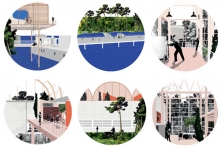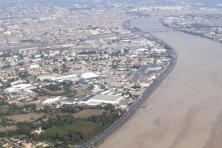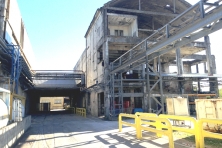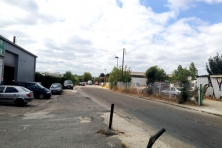Bègles and the Urban Machines
Bègles (FR) - Runner up
TEAM DATA
Team Representative: Rosalie Robert (FR) – architect
Associate: Pauline Percheron (FR) – architect
5 rue de la Folie Regnault, 75011 Paris (FR)
pauline.percheron@gmail.com – paulinepercheron.com
See the complete listing of portraits here
See the site page here

R. Robert & P. Percheron
INTERVIEW
Click on the images to enlarge
1. How did you form the team for the competition?
We met during an Erasmus exchange year at La Cambre, the Institute of Architecture in Brussels. We recently decided to set up our own office, and Europan is the first step.
2. How do you define the main issue of your project, and how did you answer on this session main topic: the place of productive activities within the city?
The project site is characterized by a building succession of large footprints that cohabit on a deserted land. Our goal was to preserve the site's identity and enhance it. Our project " Bègles and the Urban-Machines " aims to reveal the great potential of industrial structures and uses it to imagine something new. We believe that these large buildings are an opportunity to expose the architecture's ability to create the city.
3. How did this issue and the questions raised by the site mutation meet?
The Bègles-Garonne area is a great example of an industrial space on the periphery of the city, which will face soon the urban spreading. The risk for these territories is to lose their industrial heritage and to be transformed into residential areas. We have to introduce the city into the industrial framework, which will later remain the main identity of the place. Therefore, we have imagined the industrial buildings as large envelopes, where urban activities and interactions are concentrated.
4. Have you treated this issue previously? What were the reference projects that inspired yours?
The " Productive-Cities " topic has been considered several times during our study years. Generally speaking, the problematic of " Diversity and social mix " is significant for our generation, and we often have to think about how to introduce production in the daily life. Le Corbusier, with " la Machine à Habiter " has imagined architecture like a piece of city, and has taken the first steps toward the diversity we are interested in. Recently, Lacaton & Vassal have used industrial architecture devices to " make more with less ", and to provide neutral and flexible spaces. The Lincoln Road building, created by Herzog & de Meuron, also inspired us: a mega-structure made of hybrid architecture, for various uses and changing activities.
5. Urban-architectural projects like the ones in Europan can only be implemented together with the actors through a negotiated process and in time. How did you consider this issue in your project?
We initiated the project with a Manifest, that will provide us a first topic of work with our project partners. With this radical proposal, our purpose was to expose our point of view on this subject, and to plan an experimentation process. We suggested examples of actual implementation of our ideas, but we did not want to define an unchangeable architectural form. Moreover, the project idea is to go with the territory changes, studying the cases one after the other, and not to use a global master-plan.
6. Is it the first time you have been awarded a prize at Europan? How could this help you in your professional career?
It iss the first time we are Europan Runners-Up. We wish to start an interesting dialog with the City and the other partners. We could try out together a new way to create the city.
